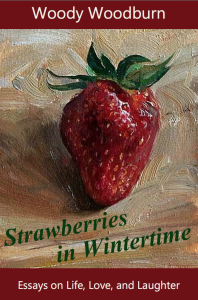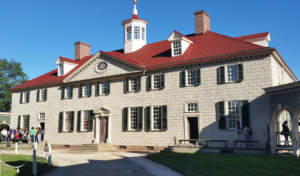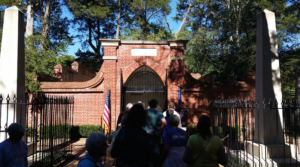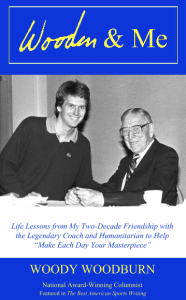 Woody’s highly anticipated new book “STRAWBERRIES IN WINTERTIME: Essays on Life, Love, and Laughter” is NOW available! Order your signed copy HERE!
Woody’s highly anticipated new book “STRAWBERRIES IN WINTERTIME: Essays on Life, Love, and Laughter” is NOW available! Order your signed copy HERE!
* * *
Goose Bumps on the Potomac River
This is the third in a four-column series chronicling my recent father-son road trip to the homes of two Founding Fathers – and more.
* * *
The evening before leaving New York City for Virginia on what we nicknamed our “Founding Father’s Field Trip,” my son took me to one of his favorite haunts, The Metropolitan Museum of Art. There was a specific painting he wanted to show me to set the mood for one of our primary destinations.
After a long hike, for The Met is the largest art museum in the United States, we arrived at a cavernous room, Gallery 670 to be precise, in the labyrinth American Wing, and there it was: George Washington, standing commandingly in a row boat with the flag raised behind him, crossing the icy Delaware River on Christmas night 1776 to attack by surprise the Hessians at Trenton.

George Washington’s mansion at Mount Vernon
The oil-on-canvas painting by Emanuel Leutze is much larger than expected. Indeed, it is truly massive, a movie theater screen almost, measuring more than 21 feet wide by nearly 13 feet high. In other words, in the framework of how we tend to view Washington, it seems about life-sized.
Washington’s mansion at Mount Vernon, by contrast, in person comes into focus smaller than anticipated. Nonetheless, the impact of visiting the historic home and surrounding grounds is immense.
Thomas Jefferson’s Monticello manor, which we had toured the previous day, is grander and fancier. No matter, Washington’s home surpassed it in goose bumps delivered, not least of all for the breathtaking view of the Potomac River below.
As Washington wrote in a letter to a friend in 1793: “No estate in America is more pleasantly situated than this . . . on one of the finest rivers in the world.” He did not seem to be telling a lie.
“History is marble, and remains forever cold, even under the most artistic hand, unless life is breathed into it by the imagination,” historian Charles Gayarré wrote. “Then the marble becomes flesh and blood; then it feels, it thinks, it moves, and is immortal.”
Walking the halls and rooms at Mount Vernon, including the bedchamber where Washington – “first in war, first in peace, first in the hearts of his countrymen” – took his last mortal breath at age 67 on December 14, 1799, breathes life into one’s imagination; the cold statue, the profile on the quarter, becomes flesh and blood.
From the mansion, Washington’s Tomb is 10 minutes by foot. Within the iron-gated red-brick vault lie two white marble sarcophagi: the one on the left is inscribed on top “Martha, Consort of Washington” while the companion on the right has a raised eagle and shield, and one word: “Washington.”

George Washington’s Tomb
The latter’s inscription may be simple, but the emotions evoked standing before it are complex and powerful. One by one and in pairs, visitors take their turn viewing. All pay their respects; most snap a photo; many seemed to pray, their lips moving silently.
Even with a constant gathering of dozens, the tomb site remains eerily quiet, void even of whispering. Occasionally, songbirds break the contemplative hush in a lovely way.
Too, the solemn silence ceases briefly at 3 p.m. daily with the changing of the wreath. The ceremony includes a reading aloud of “George Washington’s Prayer for the Nation.” On this day, a lone butterfly fluttered over the tomb entrance.
Standing in this hallowed spot, looking at the cold marble where the “Father of our Country” rests eternally, my imagination breathed to life. Images of George Washington – from Independence Hall to Valley Forge to the Delaware River and beyond – flashed in my mind’s eye.
The great man’s presence seemed almost palpable. Truly, I was caught off guard by how overwhelming were my emotions; my gratitude, awe and affection. Leutze’s famous painting of Washington more than ever seemed life-sized.
For that moment, the noticeable tear in the giant canvas of Washington’s life disappeared. However, this blot was nearby just down the pathway: the burial ground and memorial to the slaves he owned.
We will walk there in this space next week.
* * *
Woody Woodburn writes a weekly column for The Ventura County Star and can be contacted at WoodyWriter@gmail.com.
 Check out my new memoir WOODEN & ME: Life Lessons from My Two-Decade Friendship with the Legendary Coach and Humanitarian to Help “Make Each Day Your Masterpiece”
Check out my new memoir WOODEN & ME: Life Lessons from My Two-Decade Friendship with the Legendary Coach and Humanitarian to Help “Make Each Day Your Masterpiece”
- Personalized signed copies are available at WoodyWoodburn.com
- Unsigned paperbacks or Kindle ebook can be purchased here at Amazon
